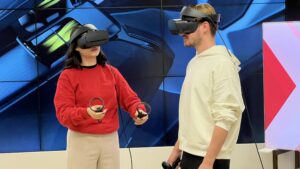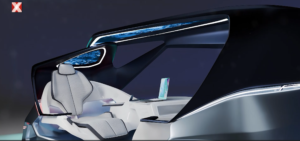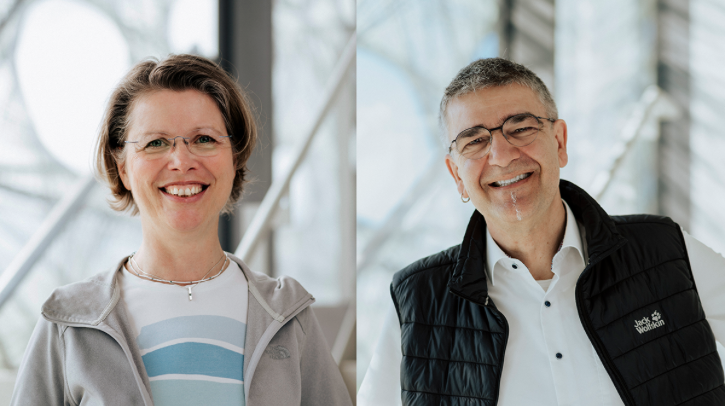This year’s Automotive Interiors Expo Europe will feature a brand-new Reutlingen University VR Zone. Automotive Interiors’ Max Wallis speaks to Prof. Andrea Lipp-Allrutz, dean of studies for the transportation interior design bachelor’s degree, and Prof. Michael Goretzky, the university’s dean of studies for design master’s degrees, to find out more
Who are you aiming to meet at Automotive Interiors Europe in Stuttgart?
We want to meet trade visitors and industry representatives who could become potential cooperation partners for us in project-oriented teaching, such as in semester projects. They could also become technological or financial sponsors. It would also be beneficial to meet all visitors to raise awareness for the transportation interior design degree program.
What can visitors to your VR Zone at the expo expect to experience?
At our VR booth, visitors will experience how we use VR in the development process. For example, you can explore the complexities of a virtual vehicle with VR glasses, created by student Rafail Kalaitzidis. Through plots and movies of transportation interior design projects, we will showcase the results that can be achieved using digital tools in the degree program. It’s a small insight into our world and into VR, but it hints at what’s possible. Of course, we use even more tools. The study program is much more comprehensive, with a holistic approach to mobility concepts.

What are the advantages of implementing virtual reality in automotive interior design?
Ultimately, we are transferring the working methods of the analog world into the virtual world. VR technology makes it possible to evaluate emotional, ergonomic and technological aspects in a virtual space. During the early stages of development, many aspects can be tested and discussed, just like in the real world. Several people can meet and discuss the model in the virtual world at the same time, and such collaboration can take place regardless of location. For instance, one person could be in Reutlingen and another in New York.
How do you see OEMs using your technology?
We see a huge benefit for OEMs. In development, it’s important to identify errors early and make the right decisions. While it won’t replace physical models, VR can streamline or expand the development process by incorporating more variants. It also supports the global working model, allowing expertise from different locations to be included without any time lag. This applies to all aspects of design development – 3D design as well as color, material and finish. Over the next few years, we believe we’ll move to mixed and extended reality. There’s great potential for development, especially with haptic perception. There are already some initial approaches, but there’s still much room for improvement.
Has VR been developed to speed up the design process? Visualize designs first? Experiment with concepts?
The games industry has provided us with a tool that makes the development process safer and ensures that we create emotional and functional results that convince the customer.
How did the vehicle that you can experience with VR glasses come about?
In the third and fourth semesters, we carry out a cooperation project with an industry partner for the entire semester. Together, we formulate a topic, and rough concepts are developed in a joint workshop with the students. These concepts are then finalized through various intermediate steps. The needs of the target group are crucial, as well as the inclusion of brand language, which the students choose themselves.

Is this an opportunity for students to present complex sets of creative factors and functional requirements that influence interior design, and then successfully implement their findings in realistic settings?
The entire program aims to prepare students for real-world work. This includes the structured and well-reasoned development of emotional solutions using state-of-the-art tools. So, the answer is yes, which is also reflected by the companies.
With the increasing trend for hyper-individualization, how does this technology help interior designers easily change their designs and collaborate with customers to create a more personalized experience?
CAD and related tools already allow us to implement changes at short notice. When working with customers, there are many ways to use VR to bring variants to life, whether in discussions with customers or consumer studies. While this technology offers a wide range of applications, we need to look at different processes and continue developing them. This is a major topic at the intersection of design and marketing, and it’s worth exploring further. With our new TEXOVERSUM building, we’ve created a space to do exactly this. Together with industry, we’ll test technologies and further develop processes. We’ve explicitly created an extended reality lab to continue exploring virtuality.
Register for your free exhibition pass to visit the Reutlingen University VR Zone at Automotive Interiors Expo Europe and experience firsthand how virtual reality is revolutionizing the automotive interior design process – it’s an opportunity to immerse yourself in the future of design and innovation!




